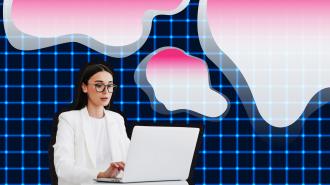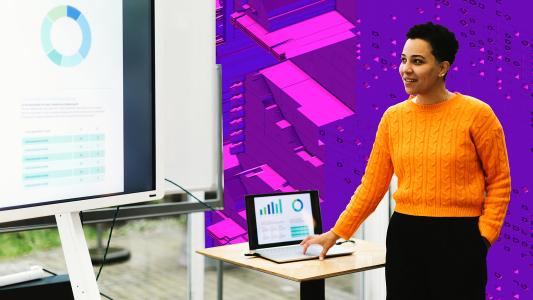This article is an installment of Future Explored, a weekly guide to world-changing technology. You can get stories like this one straight to your inbox every Thursday morning by subscribing here.
Highly advanced generative AI systems that produce images, human-like text, workable computer code, and more first stunned the world in 2022 — never before had we seen systems so capable of mimicking human creativity.
This has led to concerns that generative AIs will soon replace writers, artists, and anyone else who creates content for a living — but how well founded are these concerns?
Generative AIs churn out content faster than people can and without demanding a salary or vacation time.
The disruptor
Generative AIs are trained on huge collections of human-made content — OpenAI’s popular text-generating AI, ChatGPT, studied the entire internet, for example, and the research firm’s text-to-image AI, DALL-E 2, learned from 650 million pairs of images and descriptions.
By identifying patterns in their training data, the systems figure out how to generate new content that seems like it could have been made by a person in response to a user’s request.
On the surface, it’s easy to see why this has some creatives feeling insecure about their place in the workforce of the future — generative AIs churn out content faster than they ever could, and they don’t require a salary or vacation time.
We’ve also seen technology take over plenty of jobs once held by human workers in the past, from robots replacing factory workers on assembly lines to automated systems connecting calls once patched through by switchboard operators.
We need creatives to be a part of the workflow.
However, as impressive as today’s generative AIs are, they may be more useful as tools for creatives than as replacements of them.
Text-generating AIs, for example, will confidently write things that sound true but aren’t, so while a journalist could use ChatGPT to generate a list of potential interview questions, they’d need to fact-check the list before sending it off to an interviewee.
Meanwhile, AIs trained to generate images still have trouble including text or realistic-looking faces in them, so a graphic designer might use DALL-E 2 to quickly come up with an idea for a logo, but if they want to include text in it or format it properly, they’ll have to adjust it manually. In addition, just having good taste or understanding what works in a given context is a special skill of designers, which can’t easily be replaced by typing prompts into a box.
A limitation found across many types of generative AIs is their reinforcement of the gender and racial biases found in their training data — ask DALL-E 2 for an image of a scientist, for example, and it’ll likely generate a picture of a white male.
Researchers are finding ways to counteract this problem, but currently, we need creatives to be a part of the workflow to not only tell these AIs what to make, but also ensure their output isn’t constantly reinforcing biases.
Beyond art
While it doesn’t take much effort to imagine how generative AIs could affect writers and artists — replacing them, supercharging their work, or both — the systems could also change how people who aren’t in inherently creative jobs work, a fact that Big Tech has quickly picked up on.
On March 14, Google announced that it was incorporating generative AI into its Google Workspace products, starting with a text-generating AI for Docs and Gmail that can draft new documents on a given topic, turn a list of notes into a coherent email, and more.
Google plans to follow up this tool with ones that can generate art for presentations in Slides, quickly analyze data in Sheets, and perform other productivity-enhancing tasks, but it’s not clear when any of the AIs will be widely deployed — for now, they’re only available to testers.
Two days after Google’s announcement, Microsoft unveiled its own generative AI tool for the Microsoft 365 suite. Dubbed “Copilot,” it can generate drafts of documents in Word, pull insights from spreadsheets in Excel, and turn an outline into a presentation in Powerpoint.
Microsoft also announced a chatbot called “Business Chat” that can sift through your emails, calendar events, and more to find answers to your queries — but both it and Copilot are currently only available to testers; Microsoft says it plans to expand access “soon.”
Whenever Google and Microsoft’s new tools do roll out, they’ll make generative AI accessible to a lot of people in the places they’re already working — three billion people use Google’s Workspace apps, and Microsoft 365 has nearly 350 million paid subscribers.
Again, though, these tools require supervision, and it’s not clear whether using Copilot to generate weekly sales reports will really save workers time if they have to fact-check every line. Even if the software works almost all of the time, infrequent errors may be hard to spot and lead to large mistakes — see the long history of blunders caused by Excel spreadsheet errors.
Rather than integrating these tools into their workflows, some people might opt to keep working the way they have been — but if their employers realize generative AI can increase productivity, they might not have much choice but to get on board.
The bottom line
We’re still in just the beginning stages of the generative AI revolution, but things are moving fast — OpenAI has already released a more advanced version of the AI model powering its popular ChatGPT, and it’s currently working on an AI that will be able to generate videos on demand.
Countless other groups are developing their own generative AIs, and seemingly even more are looking for ways to integrate the systems into their products and workflows.
Generative AI has the potential to dramatically change how we work.
It’s not unreasonable to think generative AIs could replace some workers — researchers from Princeton, NYU, and the University of Pennsylvania believe teaching and telemarketing jobs are particularly susceptible to disruption because they require skills that generative AI can mimic.
It’s still too soon to know what that disruption might look like in the near term, and even less clear is how generative AI is going to affect the distant future of work — after all, who knew the creation of the internet would lead to TikTok influencers, or that the invention of the automobile would mean someone, someday, would be training robotaxis?
For now, what is clear is that generative AI has the potential to dramatically change how we work — and that the people who embrace that change stand to benefit the most from it.
We’d love to hear from you! If you have a comment about this article or if you have a tip for a future Freethink story, please email us at [email protected].






